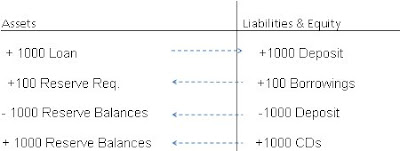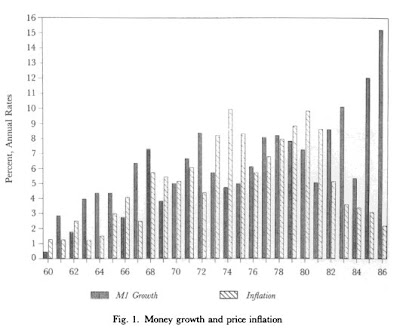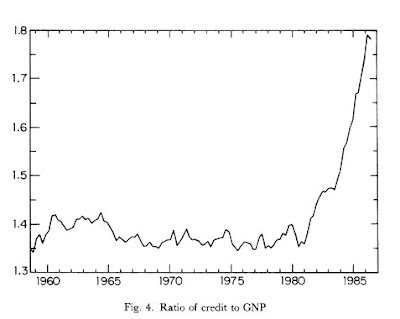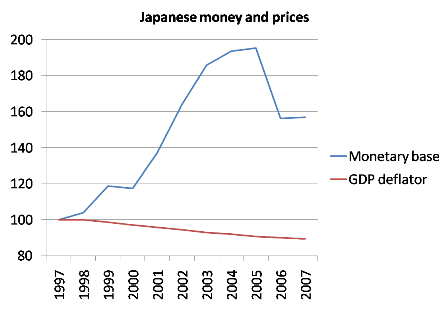By L. Randall Wray
The growing consensus view is that the worst is behind us. The Fed’s massive intervention finally quelled the liquidity crisis. The fiscal stimulus package has done its work, saving jobs and boosting retail sales. The latest data show that net exports are booming. While residential real estate remains moribund, there are occasional reports that sales are picking up and that prices are firming. Recovery is just around the corner.
Hence, many have started to call on the Fed to think about reversing its “quantitative ease”—that is, to remove some of the reserves it has injected into the banking system. Further, most commentators reject any discussion of additional fiscal stimulus on the argument that it is no longer needed and would likely increase inflation pressures. Thus, the ARRA’s stimulus package should be allowed to expire and Congress ought to begin thinking about raising taxes to close the budget deficit.
Still, there remain three worries: unemployment is high and while job losses have slowed all plausible projections are for continued slack labor markets for months and even years to come; state and local government finances are a mess; and continued monetary and fiscal ease threaten to bring on inflation and perhaps even national insolvency.
Me thinks that reported sightings of economic recovery are premature. Still, let us suppose that policy has indeed produced a resurrection. What should we do about unemployment, state and local government shortfalls, and federal budget deficits? I will be brief on the first two topics but will provide a detailed rebuttal to the belief that continued monetary ease as well as federal government deficits might spark inflation and national insolvency.
1. Unemployment
Despite the slight improvement in the jobs picture (meaning only that things did not get worse), we need 12 million new jobs just to deal with workers who have lost their jobs since the crisis began, plus those who would have entered the labor force (such as graduating students) if conditions had been better. At least another 12 million more jobs would be needed on top of that to get to full employment—or, 24 million total. Even at a rapid pace of job creation equal to an average of 300,000 net jobs created monthly it would take more than six years to provide work to all who now want to work (and, of course, the labor force would continue to grow over that period). There is no chance that the private sector will sustain such a pace of job creation. As discussed many times on this blog, the only hope is a direct job creation program funded by the federal government. This goes by the name of the job guarantee, employer of last resort, or public service employment proposal. (see
here,
here, and
here)
2. State and Local Government Finance
Revenues of state and local governments are collapsing, forcing them to cut services, lay-off employees, and raise fees and taxes. Problems will get worse in coming months. Most property taxes are infrequently adjusted, and many governments will be recognizing depressed property values for the first time since the crisis began. Lower assessed values will mean much lower property tax revenues next year, compounding fiscal distress. Ratings agencies have begun to downgrade state and local government bonds—triggering a vicious downward spiral because interest rates rise (and in some cases, downgrades trigger penalties that must be paid by governments—to those same financial institutions that caused the crisis). Note that contractual obligations, such as debt service, must be met first. Hence, state and local governments have to cut noncontractual spending like that for schools, fire departments, and law enforcement so that they can use scarce tax revenue to pay interest and fees to fat cat bankers. As government employees lose their jobs, local communities not only suffer from diminished services but also from reduced retail sales and higher mortgage delinquencies—again pushing a vicious cycle that collapses tax revenue.
The solution, again, must come from the federal government, which is the only entity that can spend countercyclically without regard to its tax revenue. As discussed on this blog in several posts (
here and
here), one of the best ways to provide funding would be in the form of federal block grants to states on a per capita basis—perhaps $400 billion next year. A payroll tax holiday would also help—increasing take-home pay of employees and reducing employer costs on all employees covered by Social Security.
3. Federal Budget Deficit, Insolvency, and Inflation
Resolving the unemployment and state and local budget problems will require help from the federal government. Yet that conflicts with the claimed necessity of tightening fiscal and monetary policy in order to preempt inflation and solvency problems. Two former Fed Chairmen have weighed in on US fiscal and monetary policy ease and the dangers posed. On NBC’s Meet the Press, Alan Greenspan argued:
“I think the Fed has done an extraordinary job and it’s done a huge amount (to bolster employment). There’s just so much monetary policy and the central bank can do. And I think they’ve gone to their limits, at this particular stage. You cannot ask a central bank to do more than it is capable of without very dire consequences,”
He went on, claiming that the US faces inflation unless the Fed begins to pull back “all the stimulus it put into the economy.”
In an interview (with SPIEGEL ONLINE – News – International) former Chairman Paul Volcker said the deficit will need to be cut:
Volcker: You’ve got to deal with the deficit and you’ve got to deal with it in a timely way. Right now, with the unemployment rate still very high, excess capacity is still evident, and the economy is dependent on government money as we said. We are not going to successfully attack the deficit right now but we have got to prepare for attacking it.
SPIEGEL: Should Americans prepare themselves for a tax increase?
Volcker: Not at the moment, but I think we would have to think about it. The present tax system historically has transferred about 18 to 19 percent of the GNP to the government. And we are going to come out of all this with an expenditure relationship to GNP very substantially above that. We either have to cut expenditures and that means reducing entitlements and certainly defense expenditures by an amount that may not be possible. If you can do it, fine. If we can’t do it, then we have to think about taxes.
Both the Fed and the Treasury are said to be “pumping” too much money into the economy, sowing the seeds of future inflation. There are two kinds of cases made for the argument that monetary and fiscal policy are too lax. The first is based loosely on the old Monetarist view that too much money causes inflation., while the second is more Keynesian, pointing toward the money provided through the Treasury’s spending. The evidence can be found in the huge expansion of the Fed’s balance sheet to two trillion dollars of liabilities and in the Treasury’s budget deficit that has grown toward a trillion and a half dollars. Chairman Greenspan, a committed Monetarist, points to the first of these, recognizing that most of these Fed liabilities take the form of reserves held by banks—which will eventually start lending their excess reserves. Chairman Volcker points to the second—federal government spending that will create income that will be spent. Hence, those trillions of extra dollars provided by the Treasury and Fed surely will fuel more lending and spending, leading to inflation or even to a hyperinflation of Zimbabwean proportions.
Some have made a related argument: all those excess reserves in the banking system will be lent to speculators, fueling yet another asset price bubble. The consequence could be rising commodities prices (such as oil prices) feeding through to inflation of consumer and producer prices. Or, the speculative bubble would give way to yet another financial crisis. Worse, either inflation or a bursting bubble could generate a run out of the dollar, collapsing the currency—and off we go again toward Zimbabwean ruin.
Finally, over the past two decades the Fed—accompanied by New Consensus macroeconomists—has managed to create a widespread belief that inflation is caused by expected inflation. In other words, if everyone believes there will be inflation, then inflation will result because wages and prices will be hiked on the expectation that costs will rise. For this reason, monetary policy has long been directed toward managing inflation expectations, with the Fed convincing markets that it is diligently fighting inflation pressures even before they arise. Now, however, the Fed is in danger of losing the battle because all of those extra reserves in the banking system will create the expectation of inflation—which will itself cause inflation. For this reason, the Fed needs to begin raising interest rates and (or, by?) removing reserves from the banking system. That would prevent expected inflation from generating Zimbabwean hyperinflation.
Unfortunately, all these arguments misunderstand the situation. Here is why:
You cannot tell much of anything by looking at current bank reserve positions. As and when banks decide they do not need to hold so many reserves, they will begin to unwind them, repaying loans to the Fed (destroying reserves) and buying Treasuries (the Fed will accommodate by selling assets in order to keep the overnight fed funds rate on target—if it did not, excess reserves would drive the fed funds rate to zero).There are no direct inflationary pressures that result from such operations. Indeed, all else equal, the reserves will be reduced with no new bank lending or deposit creation.
Banks normally buy financial assets (including loan IOUs) by issuing liabilities (including deposits). As the economy recovers, banks will want to resume such activities. If there is a general demand to buy output or financial assets, coming from borrowers perceived to be creditworthy, banks normally accommodate by making loans. This does not require ex ante reserves (or even capital if regulators do not enforce capital requirements or if banks can move assets off balance sheet). Yes, such a process can generate rising asset prices and banks broadly defined might accommodate this as they seek profits through lending to speculators. In this respect you could argue that expected inflation of asset prices fuels actual inflation of asset prices since that can fuel a speculative run up. Yet, this can occur with or without any excess reserves–indeed even if banks were already short required reserves they could expand lending then go to Fed to get the reserves. In other words, banks do not lend reserves nor is their lending constrained by reserves. Thus, while it is true that banks can finance a speculative bubble in asset prices, they can do this no matter what their reserve position is.
Nor will bank lending for asset purchases necessarily generate inflation of output prices. Any implications of renewed bank lending for CPI or PPI inflation are contingent on pass through from commodities to output prices. If the speculative binge in, say, futures prices of commodities feeds through to commodities spot prices, and if this then pressures output price inflation (as measured by the CPI and PPI), there can be an effect on measured inflation. There are lots of caveats–due to the way these indexes are calculated, to the possibility of consumer and producer substitutions, and to offsetting price deflation pressures (Chinese production and all of that). In any case, if there is a real danger that the current commodities price boom could accelerate to the point that it might create a crash or output price inflation, the best course of action would be to constrain the speculation directly. This can be done through direct credit controls placed on lenders as well as regulation of speculators.
It is true that the Fed has operated on the belief that by controlling inflation expectations it prevents inflation. Low inflation, in turn, is supposed to generate robust economic growth and high employment. This has been exposed by the current crisis as an unwarranted belief. The Wizard of Oz behind the curtain was exposed as an impotent fraud—while Bernanke remained focused on controlling inflation expectations for far too long, the whole economy collapsed around him. It was only when he finally abandoned expectations management in favor of bold action—lending without limit to institutions that needed reserves—that he helped to quell the liquidity crisis. All of his subsequent actions have had no impact on the economy—“quantitative easing” is nothing but a slogan, meaning that the Fed accommodates the demand for reserves (which it has always done, and necessarily must do so long as it has an interest rate target and wants par clearing).
It is sheer folly to believe that inflation expectations lead to inflation and that by controlling the expectations one controls inflation. In the modern capitalist economy, prices of output are mostly administered, with the caveat that competitive pressures from low cost producers in China and India put downward pressure on prices that may force domestic sellers to cut prices. Hence, US inflation has remained low in recent years because there has been little cost pressure; and note that most countries around the world have also experienced low inflation over the same period even though they did not enjoy the supposed benefits of a Wizard in charge of monetary policy. In the current environment of a global financial and economic calamity, the real danger is price deflation. The bit of inflation we do experience is due almost entirely to energy price blips—which could be prevented if we would just prohibit pension funds from speculating in commodities.
Still, there remains one path to Zimbabwean hyperinflation: a collapse of the currency due to insolvency and default by our federal government on its debts. Yet, as many have discussed on this blog (see here, here, here, here, and here), the US government is the sovereign issuer of our dollar currency. It cannot be forced into bankruptcy because it services its dollar debt by crediting bank accounts. It can never run out of these credits, since they are merely electronic entries on balance sheets, created at the stroke of a computer key. It can, and will, make all payments as they come due. In short, federal government insolvency is not possible.
To be sure, as we have emphasized many times, too much government spending can be inflationary. But the measure of “too much” cannot be found by looking at the size of the deficit (or, equivalently, at the shortfall of tax revenue), or at the ratio of government spending to GDP, or at the outstanding debt stock. Rather, government spending will approach an inflation barrier as the economy approaches full employment of resources, including labor resources. Yet, we are no where near to full employment. Any fear that current levels of spending, or even much larger amounts of federal spending, might be inflationary are premature. With 12 to 25 million jobless workers remaining, inflation is not a legitimate worry.
You can be sure that no matter how misguided President Obama’s policies might be, he is not taking us down the path to a Zimbabwean hyperinflation. This is not the place for a detailed analysis of the probable course of the dollar. In coming months it might decline a bit, or rise a bit (I’d bet on the latter if I were a gambler)—but there will be no global run out of the dollar. For one thing, runners must run to something—and as recent reports suggest, Euroland’s prospects look dire. That leaves smallish nations (Japan, the UK—both with their own problems) or big nations (China, India) that are too risky for foreigners. The best place to park savings will remain the US dollar.



















